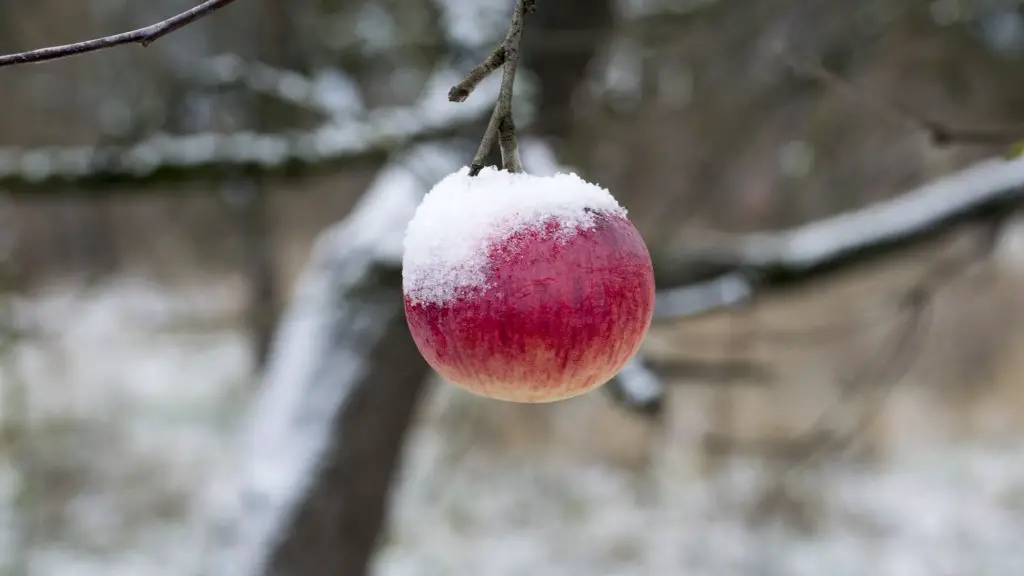Spraying an apple tree is a vital part of apple cultivation. To ensure the best results, the process should be carried out correctly. Here, we will provide you with all the information and tips needed to correctly spray an apple tree.
The first step is to consider the type of spray being used. Many different types of sprays are available, and each type is designed for a specific purpose. Therefore, it is important to select the correct one for the job. For example, pest sprays are designed to combat insect infestations, while fungicide sprays are designed to eliminate fungi from the tree.
The second step is to prepare the sprayer. This should be done carefully and thoroughly to ensure that the spray is distributed evenly. Start by ensuring that the tank is full, and all seals and filters are clean. Then, fill the tank with the relevant spray according to the manufacturer’s instructions.
The third step is to determine the target area of the tree. This can vary depending on the size of the tree and the type of spray being used. Make sure that all foliage, branches, and buds are completely covered.
The fourth step is to begin the actual spraying process. Make sure to use a slow, steady motion while doing so, and take care to remain at least 10 feet away from the tree. Also, it is important to avoid any nearby objects or plants that could be damaged by the spray.
The fifth step is to clean the equipment after use. This is essential to ensure that no residue is left behind, as this could potentially cause damage to the tree. Start by ensuring that the nozzle is tightly secured, and then rinse out the tank several times with clean water.
Finally, it is important to monitor the tree for any signs of distress. This can include wilting, discolouration, or stunted growth. If any of the above signs are noticed, it is important to take action to resolve the issue before it escalates.
Climate Conditions
When it comes to spraying an apple tree, the climate conditions must also be taken into consideration. Depending on the location and the season, the weather can drastically affect the efficacy of the spray. Therefore, it is important to ensure that the weather is mild and suitable before commencing the spraying process.
Some types of sprays, such as fungicides, require a certain amount of humidity or moisture in order to be effective. Therefore, it is important to check the humidity levels before the spray is applied. Additionally, the temperature should remain between 10-20 degrees Celsius for optimal results.
It is also essential to plan the spray in accordance with any rain forecasts. Most sprays are highly soluble and will simply be washed away by rain. Therefore, it is important to leave enough time for the spray to dry before any rain is expected.
Finally, wind speed should also be taken into account. If the wind is too strong, it can scatter the spray, causing it to be dispersed too widely. This can result in a loss of efficacy and could even damage non-targeted areas.
Safety Procedures
It is important to take all necessary safety precautions when spraying an apple tree. Ensure that all equipment is in good working order and that any protective clothing is being worn. All people involved should be wearing gloves, a face mask, and goggles for eye protection. It is also important to make sure that the area is well ventilated, as the fumes from some sprays can be very toxic.
Before spraying, it is important to read the label of the spray carefully. This will provide information about any safety concerns and precautions that must be taken. Additionally, it is essential to avoid contact with any animals or children in the area.
If any of the spray inadvertently comes into contact with the skin or eyes, it is important to immediately wash the affected area thoroughly with water. Seek medical attention immediately if there are any signs of irritation or distress.
Finally, it is important to safely store any leftover spray, or any empty containers. This should only be done in a cool, dry location that is far away from any food or animals. Label all containers clearly and keep them out of reach of children.
Application Technique
The technique for applying the spray is just as important as the process of selecting it. When spraying the tree, it is important to use a slow, steady motion and to avoid over-spraying any area. Additionally, the nozzle should be held at least 10 feet away from the tree.
It is also important to move the nozzle in a circular motion, making sure to evenly and thoroughly coat the tree. This will reduce the risk of any missed patches, as well as ensure that the spray penetrates the different layers of the tree’s foliage.
It is also important to pause the spraying every so often, to allow the spray to sink into the foliage. This should be done every few feet, or when switching between levels of the tree. Additionally, when spraying the ground around the base of the tree, ensure that the spray is distributed evenly.
When spraying wide areas of the tree, it is important to switch up the direction of the nozzle to ensure full coverage. Make sure that all foliage, branches, and buds are well-covered. Additionally, spray the trunk and base of the tree, as this will create a preventative barrier against pests.
Finally, when using a pressure sprayer, the pressure should be kept at a comfortable level. This will ensure that the particles are uniformly distributed and that the spray does not become overly concentrated in any area. Additionally, the nozzle should be constantly moving to prevent the buildup of overspray on any surface.
Clean-Up
Once the spraying process is complete, it is important to clean all of the equipment as soon as possible. Start by ensuring that the nozzle is tightly secured, and then rinse out the tank several times with clean water. Make sure to remove all traces of the previous spray before refilling the tank.
It is also important to avoid any contamination of the soil with the spray. Make sure to clean up any residue or droplets that may have been scattered. Additionally, it is important to double-check the tree’s foliage to make sure that there are no visible traces left of the spray.
It is also essential to clean the sprayer’s filters regularly. This should be done using warm, soapy water. Additionally, make sure to scrub away any clogged residue from the nozzle. Finally, the tank should be thoroughly cleaned and made ready for the next application.
Maintenance
Spraying an apple tree is not a one-time activity. It requires regular maintenance to ensure healthy growth and productivity. It is important to note that different sprays may have different application requirements. Therefore, it is essential to follow the manufacturer’s instructions precisely.
It is generally recommended that the tree should be sprayed at least twice a year. This should be done in the spring, just before the blooming stage, and in the summer, when insect activity is at its peak. Additionally, it is important to monitor the tree for signs of disease or insect infestation, as this may require more frequent or intensive spraying.
Finally, it is essential to inspect the tree regularly. This can help to identify any health issues that may require more frequent or different types of sprays. Additionally, the tree should be pruned regularly to remove weak or dead branches, as these can provide an easy entry point for pests.




